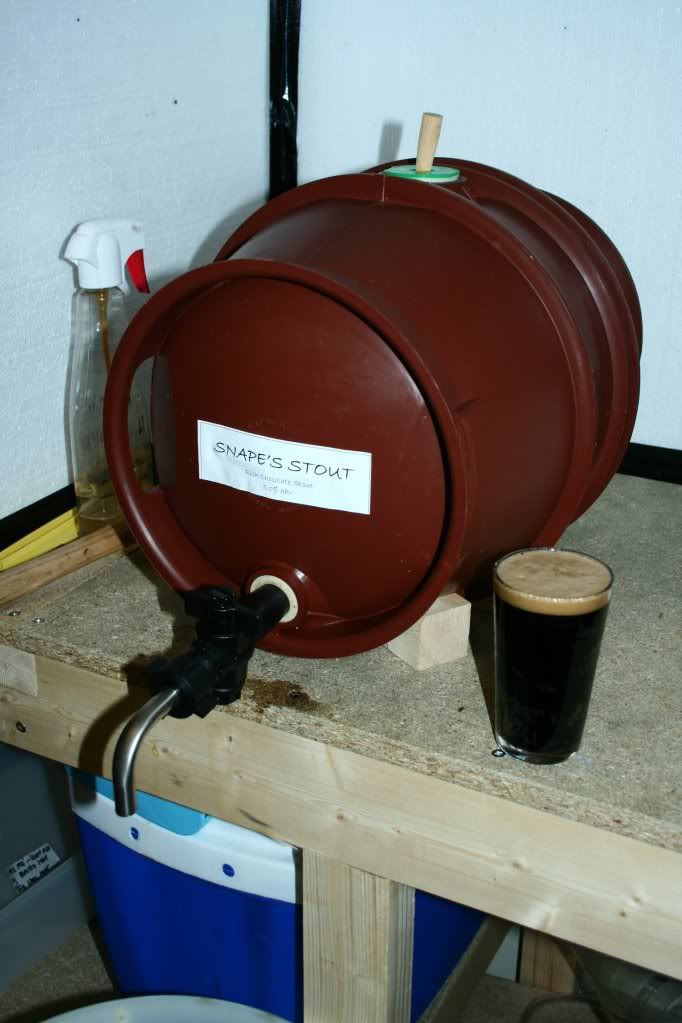I thought I'd share my findings, so to break down the different aspects of pub casks for the home brewer:
Practicality
They are harder work, without a doubt! Shives and keystones have to be bashed into the casks and then levered out when the cask is empty. However, once they have been hammered in, the casks are pretty bombproof (just look at how casks get bounced around as they land in pub cellars), so it's easy to lug them about. They are a LOT easier to carry than pressure barrels and I'd argue easier than corny kegs as they have a few different places to securely grip them by. This might seem like an insignificant point by those who have the luxury of barrels and fermenters in the same place, I lug my barrels across a yard and up a flight of stairs by myself, so I see it as bonus!
Cleaning them is obviously a different routine to a pressure barrel (and for those with skinny arms, a corny too) as it's impossible to get your hand/arm into a cask. The key here is to be pro-active and cleaning them immediately after use. I soaked them in warm water with soda crystals, followed by shaking and some hot rinses. This seems to clear all the crud out just fine. Commercially, steam lances are used, but these are too expensive and impractical for use by the homebrewer, unless you have a very friendly brewery nearby who will clean your casks for you.
Serving the beer requires the minor inconvenience of removing the spile as you pour the beer, but it's not really an issue.
Cost
The cost of the cask should be no more than £40 (for a plastic one, you are looking at probably £70+ for a stainless steel one) then there is a shive, a keystone and a spile per use so it ends up at about 80p a cask. That's just over 2p a pint if you use a pin (4.5 gallons, 36 pints), obviously it halves if you use a firkin (9 gallon) as the beer quantity doubles but the shive/keystone/spile cost is the same.
Longevity of the beer
I think the casks are excellent for maturing beer in from what I have discovered so far. I aged a 5.0% stout for about 6 weeks in one of these and there were absolutely no off tastes at all. The plastic is completely light proof too, unlike many homebrew barrels, although I realise the cornies have this same merit.
Of great concern to many reading this will be the life of the beer once vented. Once the cask has been opened, common opinion is you've got anywhere between 3 and 7 days to empty it (depending on the strength of the beer). This seems to me to be a slightly cynical perspective, perhaps because in good pubs the landlord will wait until the beer is in optimum condition (sometimes a good few days after being vented) before serving. I found my 3.6% mild was good for 6 days and the 5.0% stout was good for 10 days (and was still good as the barrel ran empty) if I started serving once I vented the beer. This is despite air being drawn in the moment one starts serving.
Flavour & condition of the beer
Well, the big question really - is it worth it? Well, in short, I would say so. The beer has a lovely natural condition that is far smoother than a corny (one of my issues with corny systems along with hop aroma being apparently sacrificed) and the flavour seems to be better (when I compared my mild that I brewed 10G of, half went into a cask and the other into a corny). I can't explain why this is the case, I can only assume it's something to do with the way the beer interacts with the oxygen in the cask . . . all I know is it tastes better.
The condition of the beer does drop off fairly quickly. The mild was underconditioned anyway (I was guessing the conditioning sugars required, I got it a bit low with the mild but the stout was much better), but the stout was quite lively initially (but I still drank it, just required careful pouring . . . I think this is one of the occasions when a landlord may let the beer sit for a day or two), with the condition lasting for 4 days or so before tailing off. The beer still tasted excellent after this, but it no longer had much condition. At this point, I connected up the Angram and served it through a sparkler as opposed to gravity that I had served it by until that point, but the Southerners wouldn't see any need for such action.
Overall - Well, I think it is worthwhile. The system is very flexible and can handle things like loose dryhopping quite easily as there are built in hop filters in the system. The casks should be especially good with hoppy ales as they are so well sealed - I shall find out soon as I have a hop bomb using Pacific Gem conditioning in one of them at the moment. The way the cask works means that you should get a crystal clear pint from start to end too. The disadvantages are that there is an additional cost involved and it requires a little more work.
Below is a photo to show that "gravity dispense" doesn't mean no condition/head - that drink was just poured straight from the tap.

Cheers!

